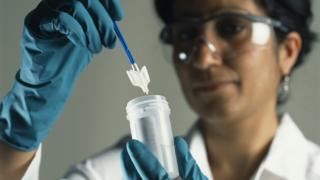
- A DIY home urine or swab test could potentially help more women discover whether they are at risk of cervical cancer, researchers say.
A DIY home urine or swab test could potentially help more women discover whether they are at risk of cervical cancer, researchers say.
The new method could be used as an alternative to the smear test and would not require a visit to the doctor.
Scientists at Queen Mary University of London asked 600 women to provide self-collected samples for screening.
Although larger trials are needed, the work has been called “promising” and a potential “game-changer” by charities.
The findings, being presented at the NCRI cancer conference in Glasgow, suggest the method is feasible and popular.
However, larger trials may still be needed before the NHS could decide whether to offer it to patients, say experts.
Even then, it would only be one option for women – as the researchers believe smear tests would continue in their current form.
But the researchers say that in the future, some women could order the test kits online, use them at home and then send their sample by post to be analysed.
The 25% who do not attend
Screening aims to pick up early warning signs of cancer – known as pre-cancers – that can be treated to prevent the disease.
All women and people with a cervix aged 25 to 64 in the UK are invited for NHS cervical screening, but the number of women attending cervical screening in the UK has been falling.
Around one in four UK women do not attend when invited, figures suggest.
Experts have put the low uptake rates down to embarrassment, a lack of awareness or just putting it off.
Dr Belinda Nedjai and colleagues have developed an alternative screening method that does not rely on smear tests.
The S5 test measures chemical changes that are detectable in urine or self-collected vaginal fluid samples to gauge a woman’s cancer risk.
A high score suggests there is an increased risk of a pre-cancer lesion being present.
In the study, the S5 test was good at distinguishing which women had pre-cancerous growths diagnosed following conventional screening.
‘Potential to revolutionise’
Dr Nedjai said the self-sampling was “pretty accurate”, but was not as quite as effective as the UK’s current smear testing programme.
“It will be soon. With improvement we’ll get there,” she told BBC Radio 4’s Today programme.
Dr Nedjai said the S5 test needed to be tried on more than 10,000 women before it could be offered on the NHS.
She predicted the at-home tests could be available via the health service in five years.
Researchers say the test could also be used alongside conventional cervical screening to help improve detection and spare some women from unnecessary investigations.
The NHS is currently moving to primary human papillomavirus (HPV) screening of smears – testing for the presence of this virus in samples before looking for abnormal cell changes. Almost all cases of cervical cancer are linked to HPV.
Dr Manuel Rodriguez-Justo, from University College London, said: “This is exciting research that shows it’s possible to detect cervical pre-cancer that is at high risk of developing into invasive cancer in urine and vaginal samples collected by women in the comfort and privacy of their own homes.
“This has the potential to revolutionise the way a positive HPV test is followed up, as well as making it easier for women in countries with no cervical cancer screening programme to be tested.”
Sophia Lowes, Cancer Research UK’s health information manager, said: “The results look promising for detecting women with advanced cell changes. But we need to know if this test picks up all changes and if it’s as successful when testing a wider group of people.”
Robert Music, chief executive of Jo’s Cervical Cancer Trust, said although more research was needed, DIY checks could be a “game-changer”.
“For women who find the current methods of cervical screening difficult, including those with a physical disability or who have experienced trauma, it could mean they can access screening in a far more acceptable and accessible way.”
“It could mean those requiring treatment are identified faster and reduce the number of women having to go for potentially unnecessary investigations at colposcopy.”



